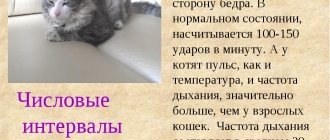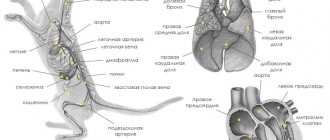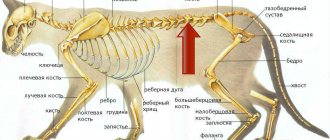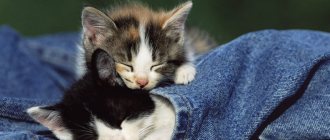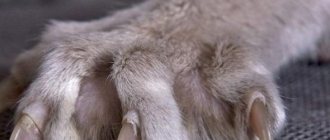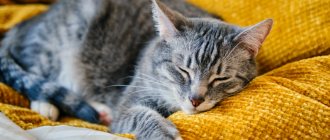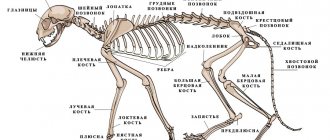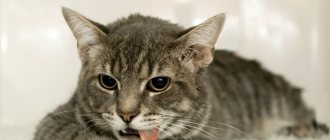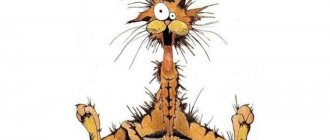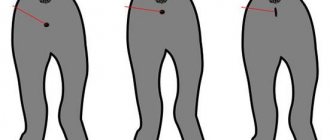5231Pavel
Some cat owners are perplexed when, counting the number of nipples on their pet, they suddenly discover that there are fewer or more of them than “naturally intended.” How many nipples does a cat have - six or ten? Ideally, there should be exactly 8. However, discrepancies also occur - from 5 to 11 nipples. This is not a pathology, but a completely acceptable situation. A cat does not have to have a certain number of mammary glands. Moreover, there is simply no risk to the life or health of the animal.
How are a cat's nipples located?
Both male and female cats have nipples. Normally there are four breast nipples located almost symmetrically, two abdominal and two in the groin area. Blood and lymphatic vessels are located vertically in the mammary glands - from the groin to the armpits.
© shutterstock
Sometimes pet owners say that a cat has 6 nipples, and they are located asymmetrically, sometimes even in a checkerboard pattern. There are also odd numbers of nipples. There is one unpaired nipple near the armpit, in the groin. Or one pair is missing one nipple. This situation occurs during intrauterine development and during puberty; one or two nipples simply have not fully formed. And this does not in any way affect the health of the ward.
Liver
The liver consists of the right lateral, right medial, left lateral, left medial, quadrate and caudate lobes; The caudate lobe consists of the caudate and mastoid processes. Ultrasonographically, the lobes cannot be differentiated. On the contrary, the liver is visualized as an integral homogeneous structure that normally contains branching portal veins. A normal ultrasound appearance of the liver does not exclude infiltrative diseases in dogs and cats.
Figure 1. (A) Longitudinal image of a dog's liver. The structure and echogenicity of the liver are normal with clear walls of the portal veins (hyperechoic) and hepatic veins (isoechoic). The curvilinear hyperechoic line separating the cranial periphery of the liver in the far field represents the reflected lung/diaphragm-liver interface. (B) Longitudinal scan of a cat's liver.
Note the hyperechoic falciform ligament fat in the near field (red arrow) with an echogenic line defining the origin of the liver parenchyma
Dog
The canine liver (Figure 1A) is hypoechoic to the adjacent spleen. Falciform ligament fat in dogs is not a reliable indicator of the overall echogenicity of the liver, as it may appear hypo-, iso-, or hyperechoic relative to the normal liver. The portal veins have distinct hyperechoic walls.
Figure 2. Longitudinal image of a cat liver. The liver is hypoechoic to the fat of the falciform ligament. The walls of the blood vessels are not as clearly visible as in a dog.
Cat
The gallbladder is a thin-walled (<1 mm), fluid-filled, anechoic structure (Figure 3). Fullness varies depending on when the last meal was and the fat content of it.
Unlike dogs, cat liver (Figure 1B) is typically isoechoic to the fat of the falciform ligament, which is thicker than that of dogs. However, the liver becomes hyperechoic in clinically obese cats secondary to fatty liver or lipidosis; or hypoechoic, as in active hepatitis or lymphoma (Fig. 2). Intrahepatic portal veins are less prominent in cats than in dogs.
Are there problems with the functioning of nipples in cats?
The main thing is not the number of nipples a cat has, but their functionality. Sometimes, a cat, even with a “normal” number of nipples, does not have enough milk when feeding kittens. And this happens quite often - the nipples do not fulfill their purpose, there is no lactation. This happens because some pathological failure occurred at the time of development.
Sometimes, on the contrary, a cat has only 5 or 6 papillae, but produces enough milk for offspring.
Problems arise when a multiple pregnancy occurs. And the number of kittens born exceeds the number of nipples in which milk is produced. Therefore, some kittens may be malnourished.
This situation can be completely resolved by carefully monitoring the babies and, if the need arises, some kittens can be fed artificially. Then all the babies will survive and be healthy and prosperous.
© shutterstock
Postoperative period: animal care
A caring owner should know what to do in the postoperative period. His main task is to accurately follow all medical recommendations:
- The most important condition is to create all the conditions for the animal to recover as quickly as possible. He needs rest for successful rehabilitation.
- The diet is compiled together with the attending physician. Only recommended foods or feeds are allowed and given in moderation. There should be no deviations from the dietary regime.
- Timely treatment of seams and surrounding tissues is important.
- Postoperative drug therapy will help create protection against infections to eliminate the possibility of complications.
- Protective bandages and blankets should be used to prevent the animal from injuring the operated area.
At the slightest hint of postoperative complications (the stitches have ruptured and pus appears, or the temperature has risen), you must immediately take the animal to the clinic.
Does the number of nipples a cat has depend on the breed?
No such dependence is observed. Cats have lived next to humans for several thousand years. During this time, many breeds of domestic cats were developed. To live in an apartment, owners usually choose medium-sized breeds, smooth-haired or fluffy. All cat breeds should have 8 nipples as a standard. No special breeds have been bred in which the number of nipples is different.
Cats of small breeds have correspondingly small mammary glands. Large breeds also have large nipples.
Cancer prevention
To reduce the likelihood of developing cancer in your cat, it is necessary to carry out sterilization in a timely manner. The recommended age for a pet is before the animal reaches puberty. At the same time, sterilization does not 100% exclude the appearance of neoplasms.
As soon as the animal reaches the most dangerous age (from 8 years), it is recommended to undergo a thorough examination at a veterinary clinic - at least once every six months. This will allow you to identify the tumor in the initial stages and completely cure your pet.
Proper care, attentive attitude and professional veterinary care are the best prevention of cancer for every cat!
Mammary gland diseases in cats
The most common mammary gland diseases in cats are::
- Mastitis
- Mastopathy
- Breast tumors
Treatment of these diseases can be either medicinal or surgical. The glands affected by the tumor must be removed so that the disease does not spread further.
Mastitis
Mastitis sometimes appears immediately after the birth of kittens, with excessive milk production during the feeding period of kittens, and it can also be caused by a false pregnancy.
This is inflammation of the mammary glands. At the same time, the mammary glands enlarge, redness of the skin in the area of the nipple is observed, the temperature of the skin itself and the whole body rises. Soreness occurs. If the owner tries to touch the belly, the cat resists and does not allow him to touch her. With the milk, a foreign liquid comes out of the inflamed mammary gland - it is yellowish in color, and there may be an admixture of pus and blood.
Kittens should never be fed this kind of milk, as this can lead to their death. Mastitis is quite easily curable, but sometimes it can recur the next time after childbirth.
Mastopathy in cats
Mastopathy is an enlargement of the mammary glands. It can be completely normal, or it can turn out to be a pathology. Ordinary, physiological mastopathy occurs at the time of false pregnancy, feeding kittens. This process occurs naturally and does not have any negative consequences.
© shutterstock
Pathological mastopathy occurs as a result of hormonal imbalance. In this case, the mammary glands become dense, and a grayish liquid appears in them. The skin around the nipples takes on a bluish tint. These are soft or quite elastic, if you touch them carefully, seals. Often this condition may be precancerous.
How to care for kittens if their mother abandoned them?
Please note that a cat who has gone into heat and has lost her milk will most likely abandon her kittens. Moreover, in the most unfavorable cases, she can simply eat them. If you want to save the babies’ lives, you will have to take on all the burdens of care. This applies not only to feeding: when raising cubs, you need to remember about numerous nuances, the observance of which determines both the health and life of the offspring.
First, examine the babies: remember that they are normally constantly moving and twitching, even when they have not yet learned to walk. If the kitten is not sleeping but looks lethargic and inactive, this is not good. In their sleep, kittens are quite calm and can practically not change the position of their body. When a baby is constantly spinning and meowing, it can mean two things: either it has some kind of health problem, or (more likely) it is very hungry.
In case you had to take on the responsibilities of a cat mother, make it a rule to examine your pets daily. Healthy young kittens have warm skin and small, round tummies (provided they are well fed). In addition, strong babies must have a strong, pronounced sucking reflex.
If kittens are healthy, they tend to beg for milk about once an hour (or once every two hours, but not less often). Accordingly, they will have to be fed with the same frequency (regardless of the time of day). The main sign of satiety of the “swallows” will be a slight swelling of their tummies and a “sudden” calmness.
In the first week, kittens, having just had their fill, fall asleep almost instantly. They sleep, as we already indicated above, for about an hour. If your pets instead fuss and squeak, then they probably don’t have enough formula.
In this case, the rounding of the abdomen can be ignored: most likely, this is air that entered the stomach during a constant squeak
Other nuances
Another problem is the tendency of kittens to become hypothermic. Their body can independently maintain a temperature of no more than 35° Celsius, and this is not enough for accelerated metabolism. It is for this reason that the mother almost never leaves the cubs in the first weeks of their life, working as a “hot water bottle.” If the cubs left without mother's care are not warmed, they will quickly die.
We invite you to familiarize yourself with the Wet tail of a rabbit - Agronomists
In ideal cases, you need to find another nursing cat and “throw” new cubs at her. In this case, you need to take a “donor” litter kitten and carefully wipe the foundling on it. Otherwise, the cat will not accept a baby that smells like another animal.
Their composition is radically different from that of cats, and therefore the use of such “ersatz” often leads to severe diarrhea. The latter, as you know, is deadly for small kittens! Babies can die from dehydration within hours.
What brands of “baby food” can I use to feed kittens? In our country, they are produced by famous manufacturers, such as Royal Canin, Beaphar, Canina.
Considering that they are not found in every pet store, it is advisable to consult with a veterinarian in advance. When using such tools, remember the following:
You can find both liquid and powdered substitutes on sale, and the latter, as you might guess, must be diluted with boiled, settled and warm water before use. As a rule, it is necessary to comply with the same requirements and recommendations as in the case of baby food (i.e., it must be diluted thoroughly, without lumps, the temperature of the finished mixture is within 37-38° Celsius.
Remember that there are milk formulas on sale intended for feeding adult cats. Such mixtures are ordinary skim cow's milk, from which all lactose has been additionally removed. Diverging slightly from the topic, we note that such food does not bring any particular benefit to adult cats (nor does it cause any harm). It can be given to kittens only in extreme cases, when there are no other options. Moreover, this should be done no more than two or three times, while searching for more suitable food for them.
Forecasts
The main prognostic factor is the size of the tumor: the median life expectancy of animals operated on with tumors larger than 3 cm is 4-12 months; 2-3 cm – 15-24 months; up to 2 cm – more than 3 years.
In a study combining surgery and chemotherapy, the median survival time after bilateral mastectomy and chemotherapy was 917 days, and after unilateral mastectomy and chemotherapy it was 348 days.
More sparing operations often lead to local recurrence, tumor invasion and distant metastasis.
Simultaneous OGE does not improve cancer prognosis.
Presence of metastases detected in the lungs – 5 months. Reactive lu - up to a year.
Chemotherapy with doxorubicin significantly increases median life expectancy. Most studies suggest that surgery and additional chemotherapy are better than chemotherapy alone. Single-mode surgery does not affect the course of the oncological process at all in the presence of metastases.
Treatment of mastitis
It should be remembered that treatment needs to be done in a timely manner. Mastitis is an inflammatory process that develops very quickly. To prevent serious consequences with serious consequences, it is recommended to consult a specialist. The doctor will prescribe antibiotics, antipyretics, anti-inflammatory drugs and medications that reduce milk production.
At the first stage of the disease, the doctor will recommend complete rest. If possible, try to isolate the kittens from her for a while and transfer them to artificial feeding. On the first day, eliminate and then completely limit drinking. Bandage the breast to prevent additional infection. Periodically wash your nipples with an infusion of sage leaves or a decoction of oak bark.
In case of complications, i.e. when phlegmon or abscesses occur, surgical procedures are used - sanitation of cavities, drainage or opening.
What does quantity affect?
Some novice dog breeders are unfoundedly afraid that the number of nipples may affect the success of feeding puppies. However, this is far from true: no matter how many tits dogs have, the main thing in this matter is the filling of the milk ducts with high-calorie milk. At the same time, the rear (inguinal) nipples produce more food, so it is recommended to place the weakest babies on them for faster weight gain.
You can judge how the mammary glands of a bitch cope with their functions by the condition and behavior of the offspring: well-fed puppies are shiny, thick-bellied, fall asleep easily after suckling and do not suffer from diarrhea. If the puppies are weak, squeak and do not gain weight, it means that the dog’s nipples are not working properly: little milk is produced, it is difficult for the babies to suck, and inflammation of the mammary gland has developed. In this case, the owner’s concern is to carefully examine the dog’s mother for the presence of traces of blood or pus in the milk. If the bitch is in good health, you can increase the productivity of the mammary glands with the help of special liquid dog food.
